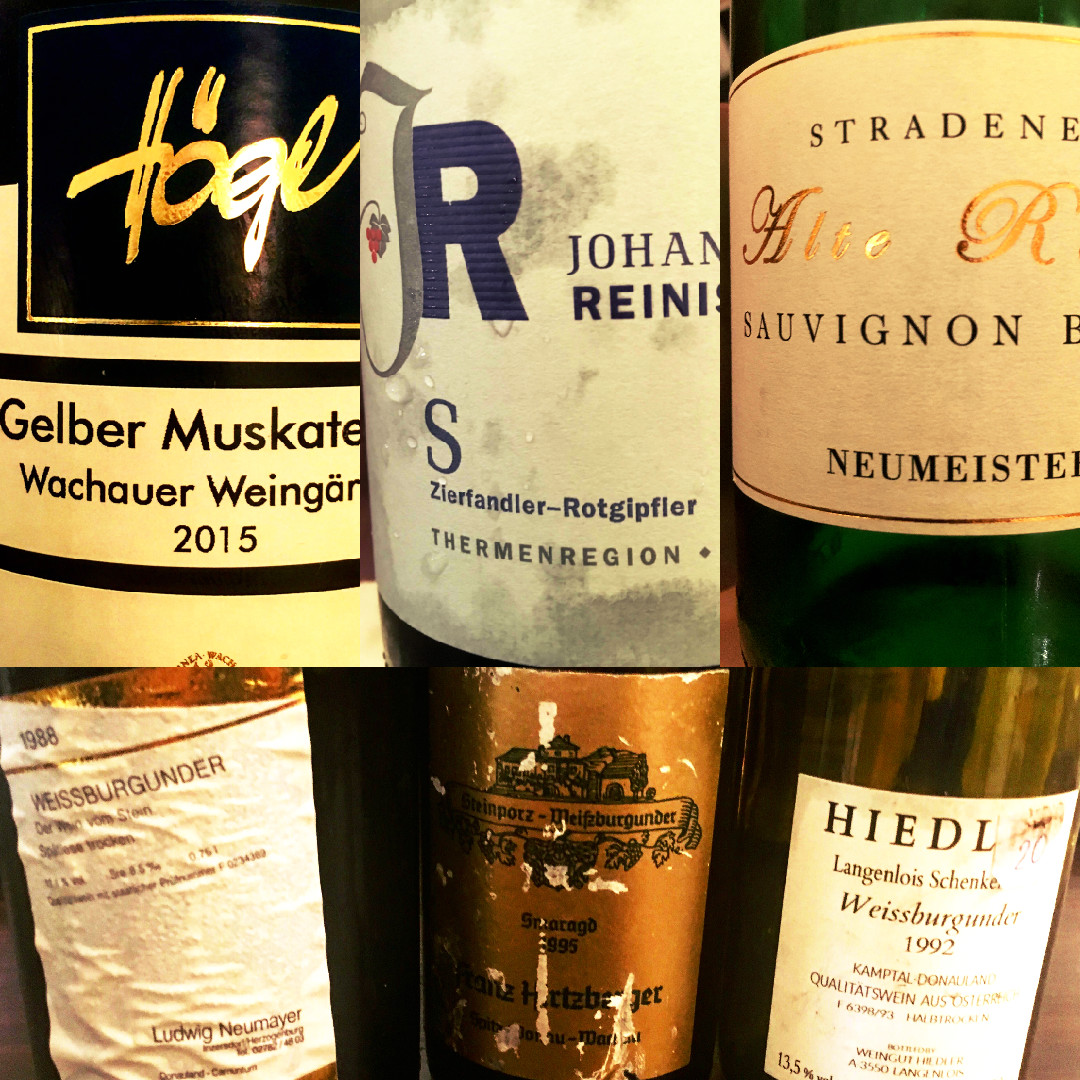While in Vienna for VieVinum, Austria’s annual wine trade fair, I tasted a huge number of producers and vintages dating back to the middle ‘80s. The quality on display raised the bar for white wine globally.
The quality floor is incredibly high, and the price ceiling (with some very few exceptions) is generally quite low. $15 liter bottles of Grüner are almost universally great patio-pounders, but that’s not the whole story. You can grab bottles with filigreed intensity from Austria’s greatest vineyards and producers for around $50-$75 US. Not cheap, but go compare Austrian prices with top-flight white Burgundy.
Internationally, Austrian whites are largely represented by world-class dry Rieslings and the calling-card white variety, Grüner Veltliner. But Austrian winemakers apply their considerable expertise to other varieties, too. Here I’ll introduce you to Austria’s particular expressions of well-known international grapes and to some of the more obscure native varieties. I’ll also recommend great producers of these wines, so you can start exploring amazing wines.
Subtle Class: Pinot Blanc (and Friends)
Known in Austria by the German-language synonym Weißburgunder, Pinot Blanc reaches a special level of quality in Austria. The grape is directly related to Pinot Gris and Chardonnay, and hews to similar aromatic themes: apple-y fruits, delicate yellow-white florals. Structurally, Pinot Blanc is a different animal.
Except for when very ripe, Pinot Blanc keeps a svelte, lighter-than-Chardonnay texture and also possesses plenty of the acid that’s generally lacking in Pinot Gris. The best examples maintain a winning balance: incredibly flavorful, but retaining refreshing drinkability.
No one region specializes in Pinot Blanc, but certain producers are partisans. Austria produces much well-made Chardonnay (called Morillon) and Pinot Gris (Grauburgunder) as well, but these grapes aren’t quite as distinctive as Austria’s Pinot Blancs.
Recommended Pinot Blanc Producers:
Aromatic Power: Dry Muscat and Sauvignon Blanc
If you like more floral-and-fruit driven aromatic wines (think dry Riesling, Albariño, or Viognier), Austria has an answer for you, as well. Austria’s Gelber Muskateller (also known as Muscat Blanc à Petit Grains) and Sauvignon Blanc should definitely be in your rotation.
Muskateller is universally fermented to dryness and combines heady, intoxicating floral aromatics with zippy acid. There’s also an appealing bitter quality—the overall effect is a sort of vinous equivalent to a gin and tonic.
The Sauvignon Blancs have a powerful punch of pristine, lush grapefruit and the stereotypical Sauvignon Blanc herbal notes manifesting as a mentholated, fresh quality. They have the tart, refreshing acid that typifies the grape but generally a little more body than you’d find in other European Sauvignon Blancs, like France’s Sancerre.
Gelber Muskateller is successful, if slightly uncommon, throughout Austria, but most of the highest-quality Sauvignon Blanc comes from the Steiermark on the southeastern corner of the country.
Recommended Gelber Muskateller Producers:
Recommended Sauvignon Blanc Producers:
Native Specialties: Zierfandler-Rotgipfler and Gemischter Satz
Austria has two particular (and particularly difficult-to-pronounce) specialties that you’re unlikely to find grown anywhere else: Vienna’s Gemischter Satz (Gehm-eesh-ter-sahtz) and Thermenregion’s traditional blend of Zierfandler (Zeer-fahnd-ler) and Rotfgipfler (Rot-gip-fler).
Gemischter Satz, which translates directly as “mixed set”, is the traditional field blend from the vineyards that literally overlook the capital city. Rather than planting varieties row-by-row, they vary on a plant-by-plant basis. In an individual row, you might have 30 pinot blanc vines, 20 Grüner vines, and 10 Riesling vines all mixed together. By law, they have to be harvested simultaneously and co-fermented. Inevitably, this means certain varieties might be a little too ripe, whereas others might be a little under-ripe.
This results in remarkably complex wine. The nose often hints at individual grapes, but the overall picture reflects the whole vineyard, since that’s only consistent factor. These wines will vary considerably in character vineyard-by-vineyard and producer by producer, but the best wines possess a spectrum of ripe, pristine fruit flavors that co-mingle harmoniously with fresh herbal and floral notes.
Last but not least, Thermenregion makes one of the most unique wines I’ve ever tasted: the Zierfandler and Rotgipfler blend. Zierfandler is aromatically tamer, verging on neutral, and is the more acid-driven of the pair. Finding wines similar to Rotgipfler proves difficult. A big-boned and savory variety, France’s Roussanne or Italy’s Ribolla Gialla might be appropriate, but neither is quite quirky enough for a direct comparison.
The best Zierfandler and Rotgipfler blends need three-to-five years in bottle to knit themselves together. Altogether ambitious wines, they mix broad texture with just-refreshing acid, but the aromatics are intensely savory: pickled yellow plum, banana, and lemon curd-ish yellow fruit are backed up by marzipan, soy-mirin, curry, and other herbaceous aromas reminiscent of lighter-style Italian Amari. Will the wine be for everyone? Decidedly not, but for those of you with a kinkier side, it’s a must-try that presents a whole range of interesting pairing possibilities.
- Recommended Gemischter Satz Producers:
- Weingut Christ
- Wieninger
- Edlmoser
Recommended Zierfandler/Rotgipfler Producers:
Whether you want to explore Austria’s take on varieties you know from this list or something wholly new, taste with confidence. Austria is making some of the most precise, ambitious, and flat-out delicious white wines on the planet. Don’t hesitate to relent to curiosity!

